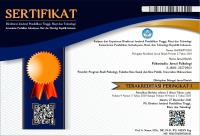Adult Attachment Style to Online Surveillance: The Role of Investment and Commitment in Young Adults’ Romantic Relationships
Abstract
Social media plays a significant role in the dynamics of romantic relationships, including the emergence of online surveillance, which refers to the act of monitoring a partner’s activity on social media. This study aims to examine the mediating roles of investment and commitment in the relationship between adult attachment style and online surveillance among 175 young adult participants currently in dating relationships. A quantitative serial mediation approach was employed. The instruments used include the Experiences in Close Relationship–Short Form (ECR-SF), the Investment Model Scale (IMS), and the Interpersonal Electronic Surveillance Scale (IESS). The results of the serial mediation analysis showed no significant mediating role of investment and commitment in the relationship between adult attachment style and online surveillance for both anxious and avoidant attachment styles. Gender was included as covariates. However, additional analysis revealed that investment functioned as a significant single mediator in the relationship between both anxious and avoidant attachment styles and online surveillance. Commitment, on the other hand, did not serve as a significant mediator. These findings indicate that online surveillance behavior is more influenced by the level of emotional investment in the relationship.
Media sosial berperan penting dalam dinamika hubungan romantis, salah satunya memunculkan perilaku online surveillance atau memantau aktivitas daring media sosial pasangannya. Penelitian ini bertujuan untuk menguji peran investasi dan komitmen sebagai mediator dalam hubungan antara adult attachment style dan online surveillance pada 175 partisipan usia dewasa muda yang sedang menjalin hubungan pacaran dengan pendekatan kuantitatif mediasi serial. Alat ukur yang digunakan mencakup Experiences in Close Relationship–Short Form (ECR-SF), Investment Model Scale (IMS), dan Interpersonal Electronic Surveillance Scale (IESS). Hasil analisis mediasi serial menunjukkan bahwa tidak terdapat peranan investasi dan komitmen yang signifikan sebagai mediator dalam hubungan antara adult attachment style terhadap online surveillance, baik anxious maupun avoidant attachment dengan jenis kelamin sebagai kovariat. Hasil analisis tambahan menunjukkan peran investasi yang signifikan sebagai mediator tunggal dalam hubungan antara anxious dan avoidant attachment style terhadap online surveillance, serta tidak ada peran komitmen yang signifikan sebagai mediator. Temuan ini menunjukkan bahwa perilaku online surveillance lebih dipengaruhi oleh besarnya investasi dalam hubungan.
Keywords
Full Text:
FULL TEXTReferences
Aloia, L. S. (2023). Antecedents and consequences of interpersonal electronic surveillance in romantic relationships. Communication Quarterly, 71(4), 436–455. https://doi.org/10.1080/01463373.2023.2228860
BERGER, C. R., & CALABRESE, R. J. (1975). SOME EXPLORATIONS IN INITIAL INTERACTION AND BEYOND: TOWARD A DEVELOPMENTAL THEORY OF INTERPERSONAL COMMUNICATION. Human Communication Research, 1(2), 99–112. https://doi.org/10.1111/J.1468-2958.1975.TB00258.X
Brennan, K. A., Clark, C. L., & Shaver, P. R. (1998). Self-report measurement of adult attachment: An integrative overview. In Attachment theory and close relationships. (pp. 46–76). The Guilford Press.
Dainton, M., & Gross, J. (2008). The Use of Negative Behaviors to Maintain Relationships. Communication Research Reports, 25(3), 179–191. https://doi.org/10.1080/08824090802237600
Dibble, J. L., & Drouin, M. (2014). Using modern technology to keep in touch with back burners: An investment model analysis. Computers in Human Behavior, 34, 96–100. https://doi.org/10.1016/J.CHB.2014.01.042
We Are Social. (2025). Digital 2025 - We Are Social Indonesia. https://wearesocial.com/id/blog/2025/02/digital-2025/
Feist, J. , & Feist, G. J. (2018). Theories of Personality (9th ed.). McGraw-Hill Education.
Fox, J., & Tokunaga, R. S. (2015). Romantic Partner Monitoring after Breakups: Attachment, Dependence, Distress, and Post-Dissolution Online Surveillance via Social Networking Sites. Cyberpsychology, Behavior, and Social Networking, 18(9), 491–498. https://doi.org/10.1089/cyber.2015.0123
Fox, J., & Warber, K. M. (2014). Social networking sites in romantic relationships: Attachment, uncertainty, and partner surveillance on facebook. Cyberpsychology, Behavior, and Social Networking, 17(1), 3–7. https://doi.org/10.1089/cyber.2012.0667
Fraley, R. C., & Shaver, P. R. (2000). Adult romantic attachment: Theoretical developments, emerging controversies, and unanswered questions. Review of General Psychology, 4(2), 132–154. https://doi.org/10.1037/1089-2680.4.2.132
Goodboy, A. K., & Bolkan, S. (2011). Attachment and the Use of Negative Relational Maintenance Behaviors in Romantic Relationships. Communication Research Reports, 28(4), 327–336. https://doi.org/10.1080/08824096.2011.616244
Himawan, Karel Karsten, Sutanto, Sandra H, Pratiwi, Pradipta Christy, & Eriksson, Lars. (2024). Men in Romance: A Scoping Review to Explore Men’s Experience in Romantic Relationships in the Patriarchal Cultural Context. The Family Journal, 32(4), 551–562. https://doi.org/10.1177/10664807231225221
Le, B., & Agnew, C. R. (2003). Commitment and its theorized determinants: A meta-analysis of the investment model. Personal Relationships, 10(1), 37–57. https://doi.org/10.1111/1475-6811.00035
Leadbeater, B., Connolly, J., & Temple, J. R. (2018). Changing Your Status in a Changing World: It Is Complicated! A Developmental Systems Framework for Understanding Dating Violence in Adolescents and Young Adults. Adolescent Dating Violence: Theory, Research, and Prevention, 3–23. https://doi.org/10.1016/B978-0-12-811797-2.00001-3
Marshall, T. C., Bejanyan, K., Di Castro, G., & Lee, R. A. (2013). Attachment styles as predictors of Facebook-related jealousy and surveillance in romantic relationships. Personal Relationships, 20(1), 1–22. https://doi.org/10.1111/j.1475-6811.2011.01393.x
Nilan, P. (2009). Contemporary masculinities and young men in Indonesia. Indonesia and the Malay World, 37(109), 327–344. https://doi.org/10.1080/13639810903269318
Norton, A. M., Baptist, J., & Hogan, B. (2018). Computer-Mediated Communication in Intimate Relationships: Associations of Boundary Crossing, Intrusion, Relationship Satisfaction, and Partner Responsiveness. Journal of Marital and Family Therapy, 44(1), 165–182. https://doi.org/10.1111/JMFT.12246
Papalia, D. E. ., & Martorell, Gabriela. (2021). Experience human development. McGraw-Hill Education.
Rus, H. M., & Tiemensma, J. (2017). “It’s complicated.” A systematic review of associations between social network site use and romantic relationships. Computers in Human Behavior, 75, 684–703. https://doi.org/10.1016/j.chb.2017.06.004
Rusbult, C. E. (1980). Commitment and satisfaction in romantic associations: A test of the investment model. Journal of Experimental Social Psychology, 16(2), 172–186. https://doi.org/10.1016/0022-1031(80)90007-4
Rusbult, C. E., & Buunk, B. P. (1993). Commitment processes in close relationships: An interdependence analysis. Journal of Social and Personal Relationships, 10(2), 175–204. https://doi.org/10.1177/026540759301000202
Rusbult, C. E., Martz, J. M., & Agnew, C. R. (1998). The Investment Model Scale: Measuring commitment level, satisfaction level, quality of alternatives, and investment size. Personal Relationships, 5(4), 357–391. https://doi.org/10.1111/j.1475-6811.1998.tb00177.x
Sumter, S. R., Vandenbosch, L., & Ligtenberg, L. (2017). Love me Tinder: Untangling emerging adults’ motivations for using the dating application Tinder. Telematics and Informatics, 34(1), 67–78. https://doi.org/10.1016/J.TELE.2016.04.009
Tokunaga, R. S. (2011). Social networking site or social surveillance site? Understanding the use of interpersonal electronic surveillance in romantic relationships. Computers in Human Behavior, 27(2), 705–713. https://doi.org/10.1016/j.chb.2010.08.014
Tokunaga, R. S., & Rains, S. A. (2016). A review and meta-analysis examining conceptual and operational definitions of problematic Internet use. Human Communication Research, 42(2), 165–199. https://doi.org/10.1111/hcre.12075
Wei, M., Russell, D. W., Mallinckrodt, B., & Vogel, D. L. (2007). The Experiences in Close Relationship Scale (ECR)-short form: Reliability, validity, and factor structure. Journal of Personality Assessment, 88(2), 187–204. https://doi.org/10.1080/00223890701268041
Wibisono, D. (2020). PENGARUH PENGGUNAAN INSTAGRAM TERHADAP EKSISTENSI DIRI REMAJA (Studi Pada Mahasiswa di Lingkungan FISIP UNILA) (Vol. 22, Issue 2).
DOI: http://dx.doi.org/10.30872/psikostudia.v14i4.21558
Refbacks
- There are currently no refbacks.
Copyright (c) 2025 Aliyya Amanda & Yudiana Ratnasari

This work is licensed under a Creative Commons Attribution-ShareAlike 4.0 International License.
Psikostudia: Jurnal Psikologi is indexed by :
PSIKOSTUDIA: Jurnal Psikologi Published by Faculty of Social and Political Siences, University of Mulawarman, Samarinda, East Kalimantan and This work is licensed under a Creative Commons Attribution-ShareAlike 4.0 International License.
_________________________________________
PSIKOSTUDIA: Jurnal Psikologi
Department of Psychology
Faculty of Social and Political Siences, University of Mulawarman
Jl. Muara Muntai Kampus Gn. Kelua Samarinda 75411
Phone: +62 813 35350368
E-Mail: psikostudia@fisip.unmul.ac.id




















